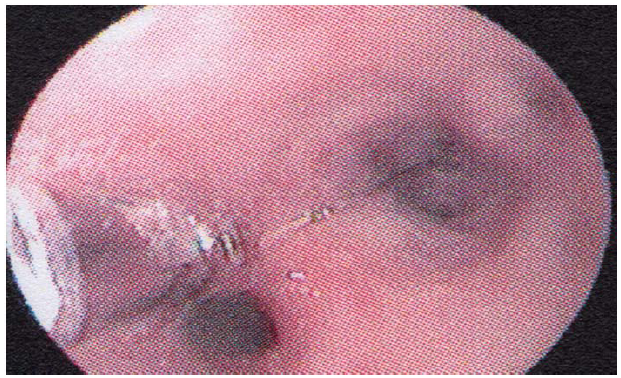Case of Endobronchial Needle Aspiration in A Patient With A False COPD Diagnosis
Osman Yaki*
Department of Thoracic Surgery, Duzce University Medicine Faculty, Duzce, Turkey
Corresponding Author*: Osman Yaki, Department of Thoracic Surgery, Duzce University Medicine Faculty, Duzce, Turkey, Tel: 90 505 309 8861;
Received: 24 October 2017; Accepted: 12 December 2017; Published: 18 December 2017
Article Information
View / Download Pdf Share at FacebookAbstract
Respiratory foreign body aspiration is a critical condition. Foreign body aspirations can be fatal or can rarely be silent. Our case, a 44-year-old female patient diagnosed as COPD at another clinic due to complaints cough and shortness of breath, applied to our service with cough, sputum and shortness of breath. The chest X-ray showed a homogeneous opacity in the lower right section. The foreign body taken out by flexible bronchoscopy and forceps was a needle. It should be noted that foreign body aspiration in adult patients may mimic diseases which cause airway obstruction.
Keywords
Bronchoscopy; Foreign body; COPD
Article Details
1. Introduction
Foreign bodies of the respiratory tract are still one of the most important issues of pulmonology and thoracic surgery. While a big sized food can cause obstruct the trachea and cause sudden death due to talking ol laughing while eating (Cafe Coronary), even a small bread crumb can cause a hypoxic crisis and death due to laryngeal spasm [1]. The great majority of foreign body aspirations, an emergency that can be fatal, are seen in children [2]. Foreign body aspirations can be seen in children, in the elderly, in those who use alcohol and sedative drugs, in neurological disease, epileptic seizures, head trauma, general anesthetized cases, and rarely in healthy adults. Tablet forms of medicines, small metal or plastic parts, foods, teeth, turban needles, tracheostomy cannula are reported foreign bodies in the literature [1,2]. In our country a drug foil aspiration was reported, which was a rare and inserting case [3]. In this case report, we aimed to present an adult patient with foreign body aspiration who received treatment for COPD at an external center and applied to our clinic.
2. Case Presentation
A 44-year-old woman with a history of cough, sputum, shortness of breath that lasted for about 6 months, and recent increase in complaints indicated that she didn’t have any complaint before. The patient aspired her turban needle while holding it between her lips, had a sudden crisis of wheezing, cough and hoarseness, her symptoms settled down after swallowing. She initially did not apply to a doctor. Approximately 6 months later, the patient was given bronchodilator medication for COPD. In spite of long-acting beta-2 agonist and inhaled corticosteroid treatment, she had persistent complaints of breathlessness, wheezing and cough. The patient was evaluated after the referral to our pulmonology polyclinic. Physical examination of the patient revealed a blood pressure of 110/70 mmHg, pulse rate of 75/min, respiration rate of 25 / min, oxygen saturation (room air) of 92% and a fever of 36.7. Localized wheezing was detected trough auscultation in the right lung lower segment. The chest X-ray showed a homogeneous opacity in the lower right section. Hemogram and biochemical findings showed no abnormality other than leukocytosis. Wbc was 13.700. Pulmonary functions tests showed mild obstruction:
FEV1: 1,86 L (64%), FVC:1,99 L (69%), FEV1/FVC: 68,5%, PEF: 3,65 (67%), FEF25-75: 1,55 L (66%). The respiratory function test was planned to confirm patient's pre-existing COPD. Pulmonary function test was evaluated according to Global Obstructive Lung Disease (GOLD) criteria [3]. Results were found to be consistent with COPD. Flexible bronchoscopy was performed for diagnostic purposes.

Figure 1: Foreign body (needle) image shown with flexible bronchoscope
Bronchoscopy was successfully performed without any complications. The foreign body, a needle, was removed. After the process; the patient was called for periodic checkup. It was observed in the control that the patient's complaints improved. The foreign body was a needle. After the procedure; the patient was called back for periodic control. Patients complaints were found to be disappeared.
3. Discussion
Foreign body aspirations are often diagnosed and treated early, since they cause early complaints such as hoarseness, stridor, cough, wheezing, and dyspnea. Delayed diagnosis of aspiration, especially in the elderly, complications such as pneumonia or atelectasis can occur. Therefore, it is very important to reliably remove the tracheobronchial foreign bodies diagnosed by flexible or rigid bronchoscopy. In patients suspected of foreign body presence, it is important to confirm the diagnosis by detailed physical examination and lung graphy as well as further examination and bronchoscopy. Our case is an adult patient with no underlying disease with foreign body aspiration who has asthma-like symptoms due to a 2-year diagnostic delay. In adults, the right main bronchus shows wider angulation with the trachea. Therefore foreign body aspiration is more common, as is in this case, in the right endobronchial system, because it can follow a straighter path from the larynx and the right main bronchus relative to the left [4]. Rigid and flexible bronchoscopy are successfully used in the diagnosis and treatment of foreign body aspiration cases. Baharloo et al. [5] reported no complications, in a series of 121 foreign body cases, with rigid (n=103) and flexible (n=9) bronchoscopy. In recent years, rigid bronchoscopy has been replaced by flexible bronchoscopy due to its advantages such as reaching more distal parts of the tracheobronchial system and not requiring general anesthesia. In a Chinese study, in patients with foreign body aspiration, the most common symptom with 67% was chronic cough. Other symptoms included; hemoptysis with 23%, fever with 19% and dyspnea with 16% [5]. In our case, both chronic cough and dyspnea were present [6]. Swanson et al. [7] successfully removed foreign bodies with flexible bronchoscopy in the majority of children. In the presented case, flexible bronchoscopy was performed without the need for rigid bronchoscopy and thoracotomy with the aid of a punch forceps. Complications associated with foreign body aspirations that cause mechanical stenosis in the airways are: bronchiectasis, atelectasis, lung abscess, pneumothorax, pneumomediastinum, hemoptysis, recurrent respiratory infections, and reactive granulation tissue. The structural features and location in the tracheobronchial system of the asphyxiated foreign body, delays in diagnosis and treatment play a role in the development of such complications [8]. Bronchoscopy is critical for both the diagnosis and the treatment of foreign body aspirations [9]. Computerized tomography should be performed in patients with nonspecific history, clinical and radiological findings. Diagnosis requires advanced methods in cases of aspiration uncertainty [9]. Radiographically; foreign body itself, ventilated lobar or segmental hyperlucency, bilateral air trapping, total lung opacification, atelectasis and parenchymal consolidation, heterogeneous or homogeneous increase in density in the lung graphy can be observed [10,11]. Foreign bodies most frequently escape to the right main bronchus, while 5-7% are located in both bronchi and 1-2% in the subglottic region [12]. In our case, the chest X-ray showed a homogeneous increase in density in the lower right section. In conclusion; in the elderly with asthma-like symptoms and shortness of breath, foreign body aspiration should be considered. Flexible bronchoscopy is a very effective and safe method for the diagnosis and removal of foreign bodies [13]. History, physical examination, radiology and other laboratory examinations are often sufficient for the suspicion of foreign body aspiration. Chest X-ray is widely used to support the diagnosis [14]. In our case, the appearance on the chest x-ray, combined with the doubt of aspiration, made us look for the foreign body. After necessary preparations, the foreign body was removed by bronchoscopy. Studies have shown that in suitable environments, by experienced practitioners, near 100% of foreign bodies have been successfully extracted [15]. However, in some studies this rate has been reported as 70% [15,16]. In our case, the foreign body was successfully removed by fiberoptic bronchoscopy after the necessary preparations. Two previous case study from Turkey, one with a stone aspiration mimicking COPD, the other one a turban needle aspiration, and their removal by fiberoptic bronchoscopy has similar features as our study and are similarly critical [17,18]. As in our case, foreign body aspirations should be demonstrated by bronchoscopy. Foreign body aspiration should always be remembered in the presence of respiratory symptoms that do not respond to treatment for long periods.
Acknowledgment
None
Conflict of Interest
The author declare that he has no conflict of interest
References
- David I, Astrachan and Clarence T, Sasaki. Tracheostomy. In Glenn's Thoracic and Cardiovascular Surge- ry. p. 604. Appleton and Lange, 25 Von Zant Street, East Norwlk Connecticut 06855,1991.
- Cangr AK, Kutlay H. Foreign body aspiration. Turkiye Klinikleri J Surg Med Sci 2 (2006): 17-21.
- Konuk S. Yeti?kin Bir Hastada AstmTaklit Eden ?laç folyosu Aspirasyonu Olgusu Klinik Tp Solunum Aktüel Dergisi 4 (2013).
- Dikensoy O, Usalan C, Filiz A. Foreign body aspiration: clinical utility of flexible bronchoscopy. Postgrad Med J 78 (2007): 399-403.
- Baharloo F, Veyckemans F, Francis C, Biettlot MP, Rodenstein DO. Tracheobronchial foreign bodies: presentation and management in children and adults. Chest 115 (1999): 1357-1362.
- Chen CH, Lai CL, Tsai TT, Lee YC, Perng RP. Foreign Body aspirationinto the lower airway in Chienese adults. Chest 122 (1997): 129-133.
- Swanson KL, Prakash UB, Midthun DE, Edell ES, McDougall JC, et al. Flexible bronchoscopic management of airway foreign bodies in children. Chest 121 (2002): 1695-1700.
- Pogorzelski A, Zebrak J, Pawlik J, Cherian Z, Buchwald J.Bronchopulmonary comlications due to aspiration of foreign bodies by children. Pediatr Pol 70 (19954): 325-331.
- Holinger P. H" Holinger L. D.: Use of Open Tube Bronchoscope in the Extraction of Foreign Bodies. Chest. 73: 721-724 (Suppl) (1978)
- Ozdimir A, Cosentino CM, Siwitz SA, Wilfond BS. Radiological case of the month, Arch. Pediatr Adolesc Med 152 (1998): 921-922.
- Tokar B, Ozkan R, Ilhan H. Tracheobronchial foreign bodies in children: importance of accurate history and plain chest radiography in delayed presentation. Clin Radiol 59 (2004): 609-615.
- Büyükyavuz . Çocukluk Çanda Yabac Cisim Aspirasyonu. Klinik Pediatri 2 (2003): 47-51.
- Cunanan O.S.: The Flexible Fiberoptic Bronchoscope in Foreign Body Removal-Experience in 300 Cases. Chest 73 (1978): 725-726.
- Hoeve LJ, Rombout J,Pot DJ. Foreign body aspiration in children. The diagnostic value of signs, symptoms and preoperative examination, Clin Otolaryngol 18 (1993): 55-57.
- Çapan N, AlcO. Trakeobronial yabanc cisim aspirasyonu. Solunum Hastalklar 20 (2009): 39-42.
- Kaya S, Yalçnkaya I, Moldibi B. Trakeobronial yabanc cisim aspirasyonlar. Solunum Hastalklar 2 (1991): 255-264.
- Bilgin C. Konuk S. Erikin Bir Hastada KOAH' Taklit Eden Ta Aspirasyonu Respiroloji Vaka Sunumlar Dergisi 4 (2016): 9-10.
- Konuk S. Fiberoptic bronchoscopy in turban pin aspiration Biomedical Research 28 (2017).


 Impact Factor: * 5.8
Impact Factor: * 5.8 Acceptance Rate: 71.20%
Acceptance Rate: 71.20%  Time to first decision: 10.4 days
Time to first decision: 10.4 days  Time from article received to acceptance: 2-3 weeks
Time from article received to acceptance: 2-3 weeks 